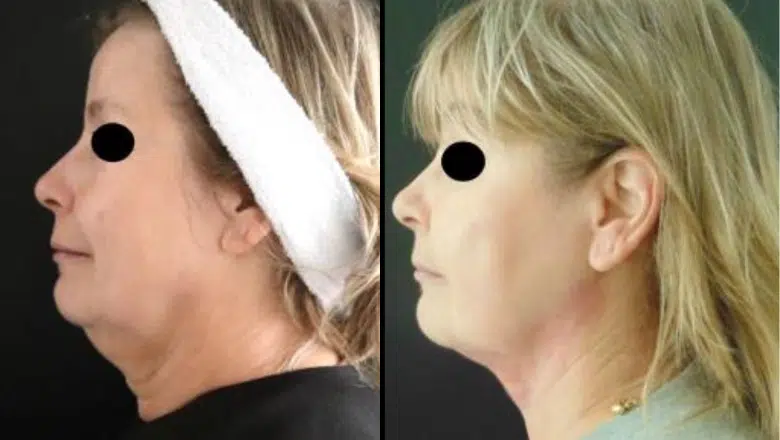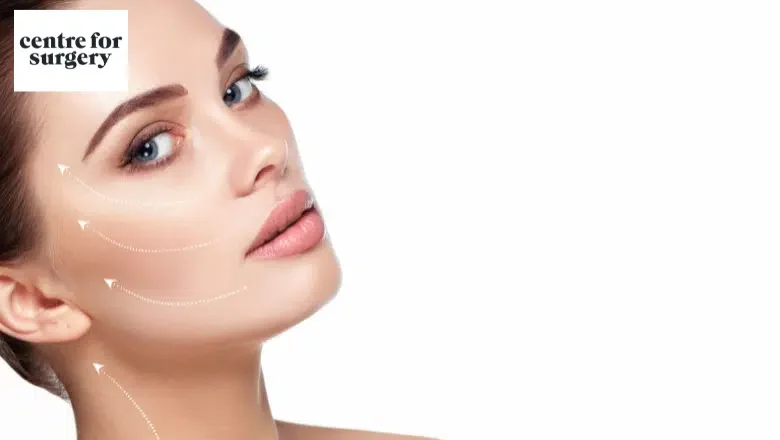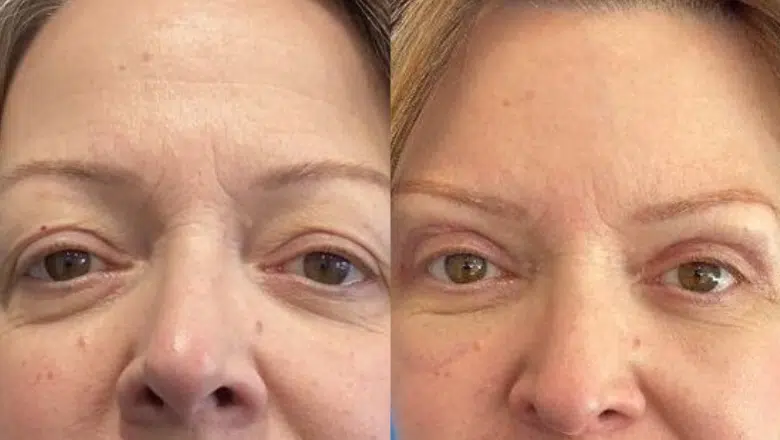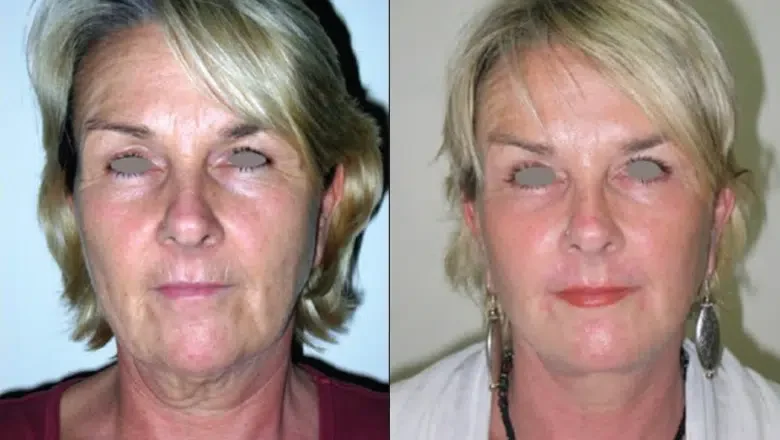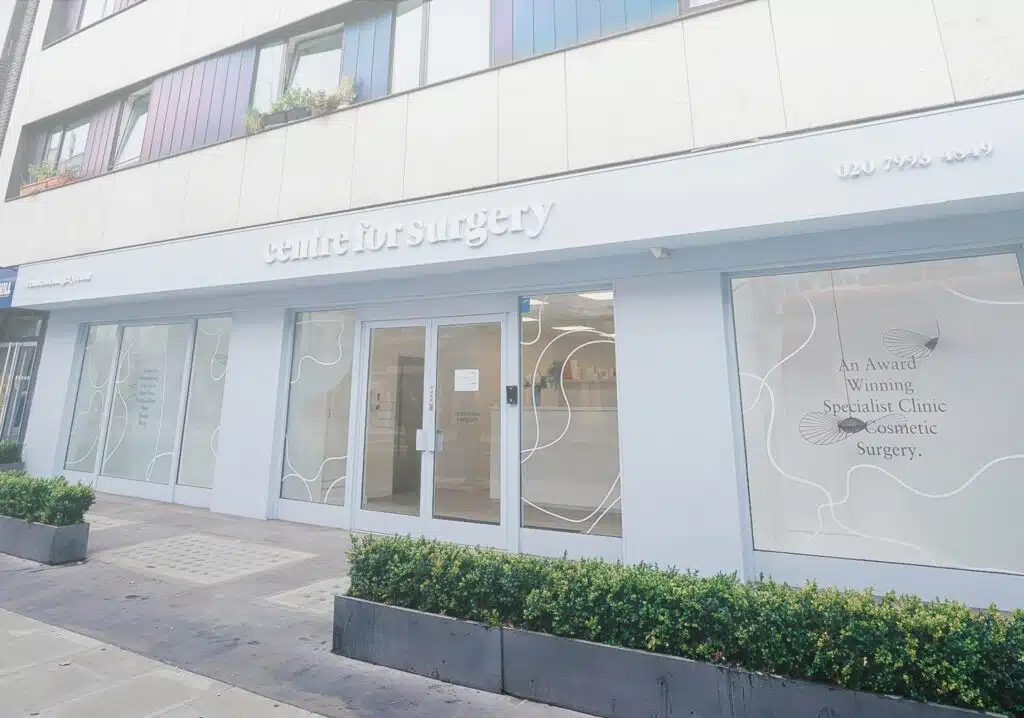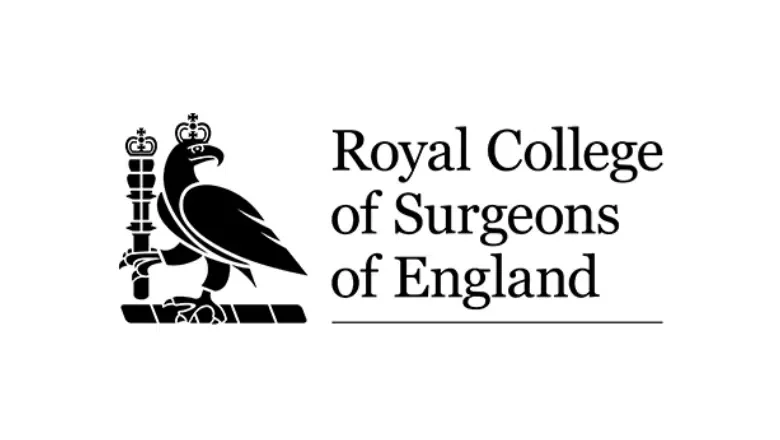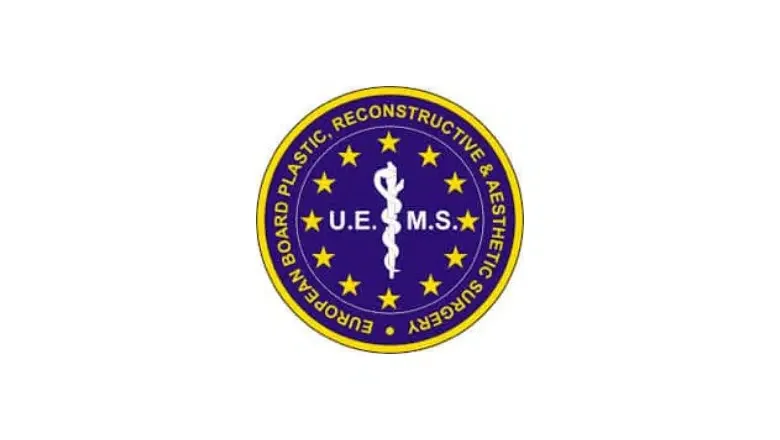How to Tighten Sagging Skin on Your Face
In pursuing youthful-looking skin, many products and treatments available in the UK promise to tighten and firm the face. However, with so many options available, it can be difficult to know which ones actually work. Conduct thorough research before committing to facial skin tightening treatments is important.
RELATED: Exploring Options for Facial Rejuvenation: In-Depth Insights
Our facial skin naturally sags and loses volume as we age, leading to a drooping appearance. While topical treatments and devices may offer some improvement, they are often unable to provide significant results. In cases of loose facial skin, facial rejuvenation surgery remains one of the most reliable options for achieving a tighter, more youthful appearance.
At Centre for Surgery in London, we recommend facelift surgery and facial fat transfer as the best facial tightening treatments currently available. Our experienced surgeons use advanced techniques to tighten the skin, lift sagging facial muscles, and restore volume to the central face for natural-looking results. Contact us for a consultation to learn more about these effective treatments.
RELATED: Facial Skin Ageing Over Time: What to Expect at 30, 40, 50
What Causes Saggy Skin on the Face?
Several factors can cause sagging facial skin, including:
Dehydration
Dehydration can cause facial skin to lose its elasticity and appear saggy. When your skin lacks sufficient moisture, it loses its natural plumpness and suppleness. This can result in a tired and saggy appearance, especially on the face.
Genetics
Genetics plays a significant role in skin elasticity and overall aging. Some people are naturally predisposed to have less collagen and elastin in their skin or have a slower rate of production. This can make them more prone to developing saggy skin on the face earlier in life.
Poor Nutrition
A diet lacking in essential nutrients, vitamins, and minerals can contribute to saggy facial skin. Nutrients like vitamin C, vitamin E, and omega-3 fatty acids are crucial for maintaining healthy skin. When your diet lacks these nutrients, it can result in reduced collagen production and decreased skin elasticity.
Lack of Exercise
Regular physical activity helps improve blood circulation, which is essential for delivering nutrients and oxygen to your skin. When you don’t exercise regularly, your facial skin may not receive the necessary nutrients to maintain its elasticity, leading to sagging.
Repetitive Facial Expressions
Over time, repetitive facial expressions can cause the skin to lose its elasticity and result in sagging. For example, smiling, frowning, and squinting can cause the skin to fold and crease. As you age and lose collagen, these creases can become more pronounced and contribute to saggy facial skin.
Environmental Factors
Pollution, harsh weather conditions, and other environmental factors can also contribute to sagging facial skin. Pollutants and free radicals in the environment can damage skin cells and break down collagen and elastin. Similarly, harsh weather conditions can strip the skin of its natural oils, leading to dehydration and reduced skin elasticity.
Facial Skin Tightening Treatments: An In-Depth Look at the Non-Surgical Options
Loose and saggy facial skin can be a concern for many people, but fortunately, there are a variety of skin tightening treatments available. These treatments range from non-surgical to surgical options, and their effectiveness can vary. Generally, more invasive procedures tend to produce more significant and long-lasting results. It is essential to understand that topical treatments and creams have limitations and cannot provide facelift-like results, despite marketing claims.
How to Tighten Facial Skin
Achieving tighter facial skin often starts with preventive measures. It’s crucial to eliminate lifestyle factors that might accelerate skin sagging. But if you’re already noticing changes in your skin’s firmness, there are several ways to help lift and tighten your facial features.
RELATED: How to Tighten Sagging Skin on Your Face
Understanding Firming Creams and Lotions
Many skincare brands offer firming creams and lotions that claim to lift and tighten the skin, often containing collagen and elastin. These ingredients are vital for maintaining plump, youthful skin. However, the effectiveness of these products can be limited. The collagen and elastin molecules in these creams are generally too large to penetrate the skin deeply, meaning they might not significantly rebuild or strengthen the dermis.
Nonetheless, certain skincare ingredients can aid in firming the skin. Products containing high levels of active ingredients like vitamin A or retinol can be beneficial. When applied topically, retinol can enhance the skin’s elastin and has shown promise in small studies for building elastin. Additionally, exfoliants with salicylic acid (BHA) or glycolic acid (AHA) are known to help rebuild collagen and improve skin texture.
The Role of Supplements in Skin Firmness
The beauty industry has seen a surge in collagen supplements that promise a range of health benefits, including treating loose skin. These supplements claim to deliver collagen peptides that improve skin elasticity and reduce fine lines. However, it’s important to note that limited clinical evidence supports these claims, and they may not be the most effective solution for skin sagging.
Face Yoga: A Natural Alternative
Face yoga offers a natural alternative for those looking to improve sagging skin. This method involves specific facial exercises and massages that stimulate the muscles, skin, and lymphatic system. Face yoga is believed to relax facial muscles, potentially smoothing out dynamic wrinkles caused by repetitive facial expressions. Proponents also suggest that it can strengthen facial muscles across the upper, mid, and lower face, contributing to a more youthful and firmer appearance.
Non-surgical Cosmetic Procedures to Tighten Facial Skin
To address sagging skin, consider the following treatments:
Non-surgical facial skin tightening treatments use targeted energy to heat the deep layers of the skin, stimulating collagen production and resulting in firmer, tighter skin. Some popular non-surgical treatments for facial skin tightening include:
- RF Microneedling: Radio-frequency (RF) treatments such as Morpheus8 use energy to heat the skin’s deep layers, promoting collagen synthesis and skin tightening. There are various RF devices available, including monopolar, bipolar, and multipolar systems.
- Fotona4D is an advanced laser treatment designed to rejuvenate and tighten facial skin, offering a cutting-edge solution for those seeking non-invasive cosmetic procedures. This innovative technology harnesses the power of two complementary laser wavelengths, delivering a multi-dimensional approach to skin tightening and anti-ageing.
- Laser therapy: Laser skin tightening treatments use focused light energy to heat the skin’s deeper layers, stimulating collagen production and resulting in a firmer, more youthful appearance. Different types of lasers, such as ablative and non-ablative, can be used for this treatment.
Each non-surgical option has unique benefits and potential side effects, so it is crucial to research and consult with a professional to determine the best treatment for your specific needs and goals.
RELATED: What lifestyle factors can affect signs of ageing on your face?
Cosmetic Injectables
Cosmetic injectables offer another popular non-surgical solution to achieve a more youthful appearance. These treatments work by plumping up the skin and filling in wrinkles and lines. Common cosmetic injectables used for facial skin tightening include:
- Anti-wrinkle injections: Also known as neuromodulators, these injections work by temporarily relaxing the facial muscles responsible for wrinkles and fine lines, resulting in a smoother appearance.
- Dermal fillers: These are gel-like substances, typically made from hyaluronic acid, that are injected beneath the skin’s surface to add volume, smooth out wrinkles, and provide a subtle lift.
- Skin booster injectables: These hydrating micro-injections contain hyaluronic acid and vitamins, which help to improve skin texture, elasticity, and overall radiance. An example is Profhilo.
FaceTite for Facial Skin Tightening
FaceTite is a revolutionary advancement, offering a minimally invasive solution for those seeking to redefine and enhance their facial contours without the need for traditional surgery. At Centre for Surgery, we are proud to be at the forefront of this innovative technology, providing our patients with a cutting-edge option for facial skin tightening that delivers remarkable results.
The Science Behind FaceTite: Precision and Innovation
FaceTite utilises radiofrequency-assisted lipolysis (RFAL) technology to target the deeper layers of the skin, promoting collagen production and tightening the skin from within. This procedure is meticulously designed to heat the skin’s underlying networks of collagen and elastin fibres, encouraging them to contract and, thus, tighten. The precision of the FaceTite device allows for targeted treatment of facial areas prone to sagging and volume loss, such as the jawline, cheeks, and neck, offering a more defined and youthful appearance.
The beauty of FaceTite lies in its ability to significantly improve skin laxity and facial contours with minimal downtime and reduced risk compared to traditional facelift surgery. This technology bridges the gap between noninvasive treatments and surgical procedures, making it an ideal choice for those seeking dramatic results without the extensive recovery period.
Surgical Procedures for Tightening Facial Skin
Surgical facial skin tightening treatments offer the most dramatic and long-lasting results when addressing sagging and loose facial skin. These procedures involve physically pulling and adjusting the skin to create a firmer, more youthful appearance. Surgical treatments are especially beneficial for tightening sagging jowls or lifting droopy eyelids.
Each individual is unique, and the surgical approach will depend on your needs and goals. The first step in determining the best course of action is to consult with a qualified surgeon who can help you understand your options and develop a tailored plan for achieving your desired results. Some common surgical procedures for facial skin tightening include:
Eyelid Surgery (Blepharoplasty): Reviving the Windows to the Soul
Eyelid surgery, or blepharoplasty, is a targeted surgical approach aimed at rejuvenating the area around the eyes, which is often one of the first to show signs of ageing. This procedure involves carefully removing excess fat and skin that can accumulate around the eyes as we age, leading to a tired or aged appearance. By addressing these concerns, eyelid surgery restores a more youthful and refreshed look to the eyes, making them appear brighter and more alert.
This procedure can also have significant functional benefits for individuals experiencing severe drooping of the eyelids. In some cases, the sagging skin can hinder vision; by removing this excess tissue, eyelid surgery can improve the visual field, making daily activities easier and enhancing overall safety.
The Art of Brow Lifting: A Solution to Age-Induced Changes
The brow lift, a sophisticated surgical procedure, is designed to counteract the natural descent and flattening of the eyebrow that occurs with diminishing skin elasticity over time. This procedure is not a one-size-fits-all; it employs various techniques tailored to meet the unique needs of each individual. A brow lift rejuvenates the area above the eyes by meticulously removing excess skin, tightening the underlying tissues, and carefully redraping the skin on the forehead. The result is a brow that is lifted and more defined and contributes to a more vibrant and alert appearance.
RELATED: Exploring the Gliding Brow Lift: A Revolutionary Approach to Forehead Rejuvenation
Face Lift: Restoring Youthfulness to the Mid and Lower Face
A face lift, also known as a rhytidectomy, involves tightening facial skin by removing excess skin and re-draping it to create a smoother, more youthful appearance. The primary goal of a face lift is to improve the appearance of the mid-face and lower-face areas. This procedure is beneficial for treating jowls and deep nasolabial folds, which can contribute to an aged look.
Facial Fat Transfer: Rejuvenating the Face with Your Own Fat
Facial fat transfer is a procedure that restores lost facial volume by harvesting fat from one area of the body and injecting it into areas of the face where volume is lacking. This not only plumps and tightens the facial skin, but it can also reduce sagging by allowing the skin to stretch over a larger surface area. The result is a more youthful, rejuvenated appearance with fewer lines and wrinkles.
Neck Lift: Enhancing the Neck and Jawline
A neck lift, or lower rhytidectomy, tightens the skin around the neck by removing excess skin and re-draping it to create a more defined and contoured appearance. The primary goal of a neck lift is to improve the appearance of the neck and jawline, which can significantly enhance one’s overall facial aesthetics. A neck lift is often combined with a facelift to achieve optimal results and create a harmonious, youthful look.
Chin Augmentation
Chin augmentation, or genioplasty, is a transformative cosmetic surgery aimed at enhancing the appearance of the chin. For individuals who feel their chin appears too weak or recedes into the neck, this procedure offers a solution to create a more pronounced and aesthetically pleasing chin. The essence of this surgery lies in its ability to redefine the contours of the chin, either through the modification of the chin bone itself or by inserting implants.
RELATED: Solutions for a Receding Chin
This surgical technique is tailored to address various concerns related to the shape and size of the chin. By either reshaping the bone or using implants, the surgeon can significantly improve the chin’s prominence, leading to a more harmonious balance with the rest of the facial features. The outcome is not just about a more pronounced chin but also involves tightening the lower face. This additional effect contributes to an overall more defined facial structure, enhancing the face’s profile and frontal view.
Thread Lift
The surgical thread lift presents a more comprehensive solution for those facing more pronounced sagging and the deeper effects of ageing. This procedure delves deeper into the facial structure, employing permanent sutures to lift and reposition the underlying layers of facial tissue. The surgical approach is meticulously designed to address significant sagging, offering a more pronounced and long-lasting lift than its non-surgical counterpart. While the promise of enduring results is appealing, it comes with the consideration of a longer recovery period, making it a suitable choice for individuals prepared for a more involved procedure.
How to Tighten Sagging Skin on Face: Best Surgical Treatment
A facelift and facial fat transfer combination is considered the most effective method for tightening sagging facial skin. This comprehensive approach addresses both skin laxity and volume loss, resulting in a smoother, tighter, and more youthful appearance.
RELATED: Can You Combine Facial Fat Transfer With a Facelift?
During this procedure, sagging skin is pulled taut, excess skin is removed, and areas with diminished volume are filled using your body’s fat. Often, facial fat grafting involves liposuction of the chin area to harvest the necessary fat. This additional step helps to remove excess chin fat, creating a more defined and contoured side profile. The end result is a revitalized and more youthful appearance without sagging skin.
Facial Fat Grafting Recovery: The recovery period for facial fat grafting typically lasts around two weeks. During this time, you may experience some bruising, swelling, and tenderness in the treated areas. However, these side effects should gradually subside within a few days. Once the initial healing phase is complete, you’ll be able to fully appreciate the results of your facial fat transfer, enjoying a smoother, tighter, and rejuvenated appearance. Keep in mind that following your surgeon’s post-operative care instructions is crucial for ensuring a smooth recovery and optimal results.
Best Facial Skin Tightening Treatment – Our Expert Recommendation
Determining the best treatment for facial skin tightening depends on your individual appearance, concerns, and desired outcomes. The ultimate goal is to provide you with the most effective and long-lasting solution tailored to your specific needs.
Our experienced surgeons often recommend combining facial fat transfer with facelift surgery for optimal results. This dual approach helps to create a more youthful and vibrant appearance by addressing both skin laxity and volume loss.
Facial fat transfer smooths out creases and lines that can contribute to an aged appearance, such as deep nasolabial lines, marionette lines (around the mouth), thinning lips, sagging cheeks, and hollowing under the eyes. By increasing volume in these areas, sagging skin becomes less prominent.
When combined with a facelift, loose skin can be expertly excised and tightened, leaving you looking more youthful and rejuvenated. This comprehensive approach addresses multiple signs of ageing simultaneously, providing a harmonious and revitalised appearance.
Face Skin Tightening FAQs
How Do You Fix Saggy Cheeks?
Saggy cheeks can be addressed through various methods, depending on the degree of skin laxity and individual preferences:
- Dermal fillers: Injecting dermal fillers into the cheeks can add volume and provide a subtle lift.
- Fat transfer: A facial fat transfer to the cheeks can restore lost volume and improve the overall appearance of the mid-face.
- Lower facelift surgery: A facelift is the most effective method for fixing saggy cheeks, as it removes excess skin and tightens the underlying tissues, resulting in a more youthful appearance.
RELATED: Sunken Cheeks – Causes & Treatments
Does Fat Grafting Help With Wrinkles?
Facial fat grafting can improve the appearance of wrinkles by adding volume to targeted areas. Fat grafting can create a smoother, more youthful appearance by filling in creases and plumping the skin.
RELATED: What is facial fat grafting?
Does Facial Fat Grafting Leave Scars?
Facial fat grafting is a minimally invasive procedure that does not involve large incisions or stitches. Consequently, the risk of scarring is minimal. Any scarring that does occur is typically limited to small needle marks, which fade over time.
How Long Does Fat Transfer Last in the Face?
Fat transfer to the face is considered a long-lasting rejuvenation treatment. In most cases, facial fat grafting results can last several years. However, individual results may vary, and factors such as ageing, lifestyle, and skin elasticity can impact the longevity of the outcome.
RELATED: Is facial fat transfer permanent?


